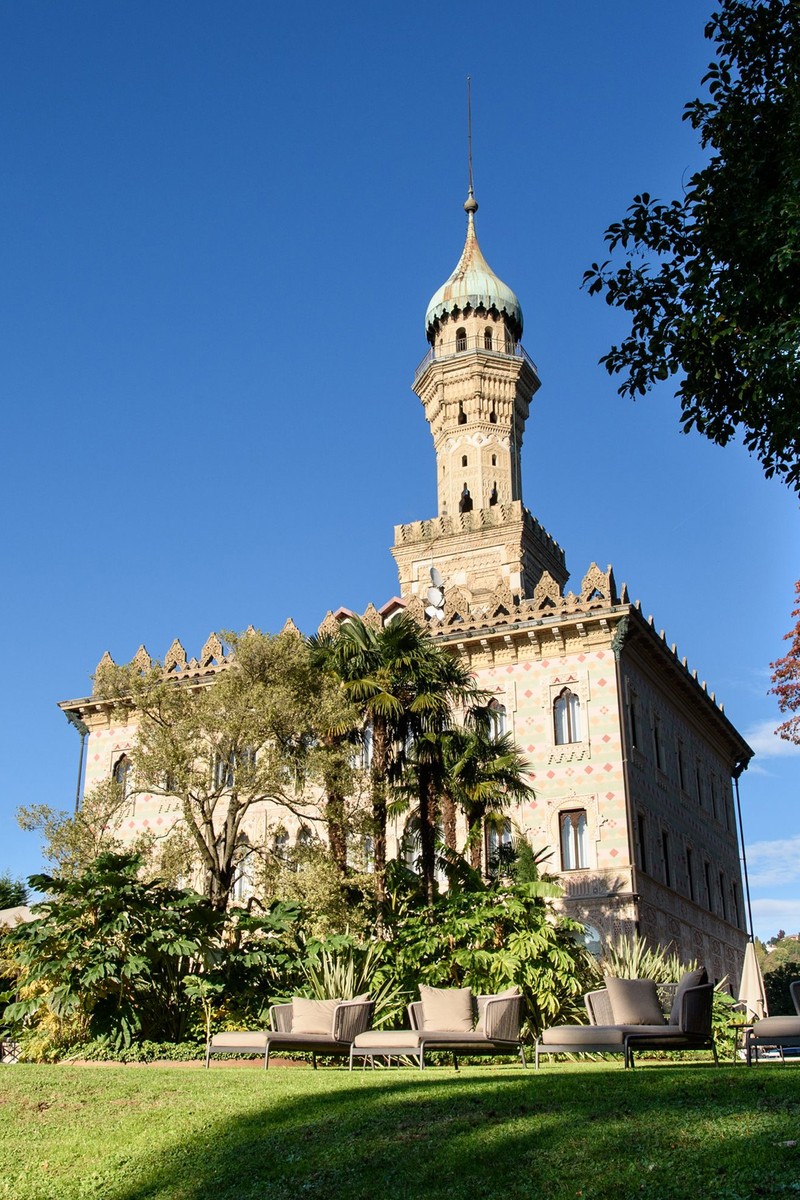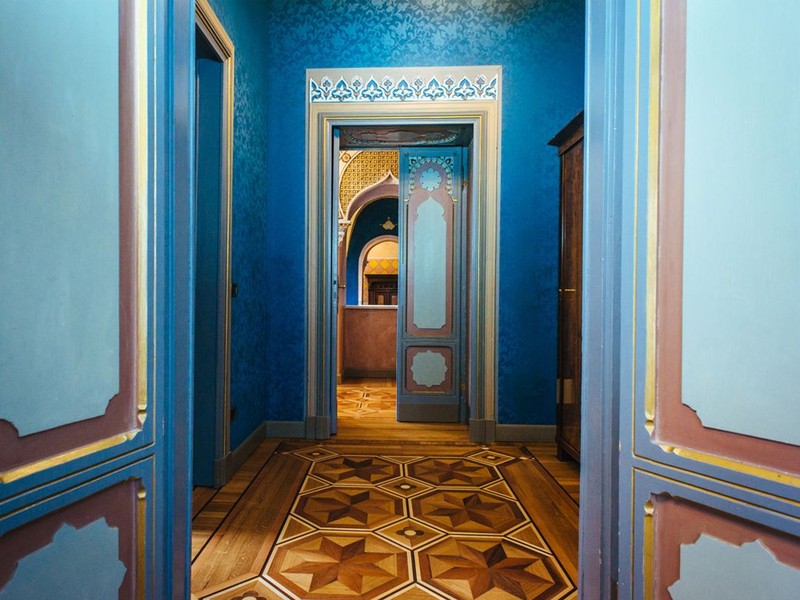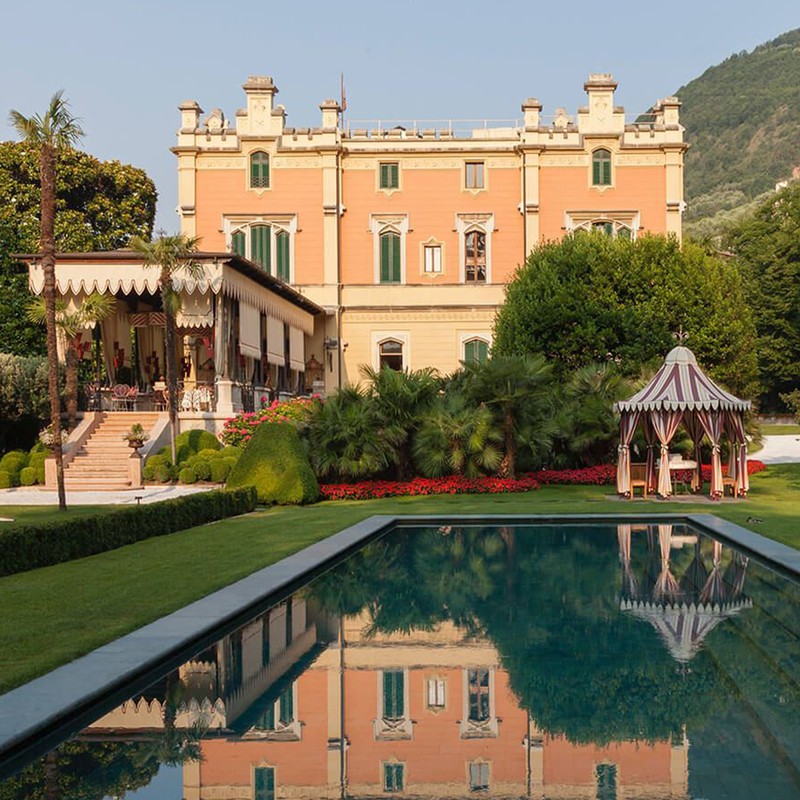
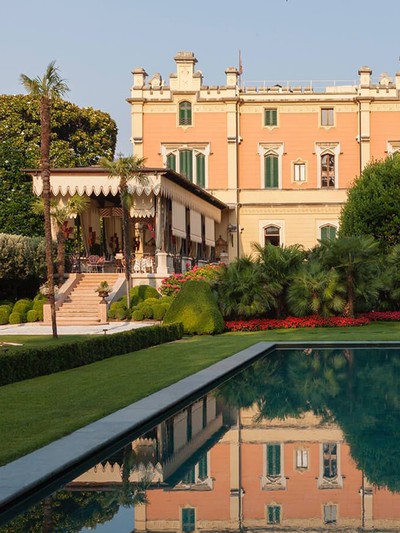
Our Pick Of The Italian Lakes
LAKE COMO
Lake Como, one of the deepest in Europe, is set in the Lombardy region at the foothills of the Italian Alps. Its glitzy reputation precedes it – it has been the playground for aristocrats, artists and celebrities for centuries, and still retains its reputation as one of the most glamorous and stylish places for an Italian escape.
Things To Do & See…
A boat tour of the lake is among the top-rated things to do. You can hire a private taxi boat or take a ferry. Head to the lake’s eponymous ‘capital’ of Como, located on the Italian-Swiss border, overlooking the southwest end of the lake. From the boat’s deck, you can see the picturesque ravine at Nesso, spot George Clooney’s handsome 18th-century villa and the palatial Villa Fontanelle where former owner Gianni Versace entertained the likes of Sir Elton John and Princess Diana.
It’s worth spending a few hours in Como with its lakeside promenade and the imposing 15th-century cathedral in the main square. For great shopping, the fishing village of Varenna on the lake’s eastern shore is a must. Its narrow, cobbled alleys and piazzas are dotted with lovely artisan boutiques and clothes shops, as well as cafés, restaurants and gelaterias. It is also home to some of the area’s most elegant villas with botanical gardens. Bellagio is known as the ‘Pearl of Lake Como’ and is located on the promontory that separates the two southern branches of the lake. It has a lovely historic centre as well as some beautiful gardens to visit. Wine lovers should visit Enoteca Principessa where the wine shop’s owner will introduce you to his wide selection of local wines. Other towns worth visiting include Tremezzina, Lecco, Cernobbio and Nesso.
For something a little more strenuous, a bike ride is another great way to get around. For keen walkers, there are numerous trails with all levels of difficulty that showcase the very best of the lake and its surrounds – you’ll discover hidden sanctuaries, remote 12th-century abbeys, stone-built mountain villages and breathtaking views linked by centuries-old pilgrim pathways.
Where To Stay…
Many of the historic villas and palazzos lining the shore of Lake Como have been transformed into some of the grandest hotels in the world – and most with an eye-watering price tag to match. But if you’re after a stay in an ultra-luxe and wonderful hotel where you can sit on a terrace or deck to soak in the stunning views, we’ve rounded up some of our favourites.
Above the village of Moltrasio, Passalacqua opened last summer and can only be described as Lake Como at its most glamorous and impressive. A little sister to the iconic Grand Hotel Tremezzo (see below), the historic mansion is steeped in history – it was once the home of the composer Bellini and also housed Napoleon and Churchill. The 24 rooms and suites are spread across the main historic 18th-century villa, the ancient stables and Casa al Lago located right on the lake. Inside, the décor is sumptuous – think grand staircases, ornate Baroque furnishings, gilded mirrors, original stuccowork, Murano chandeliers and frescoes. Outside, the tiered gardens are beautiful and peaceful, and go right down to the lake; there is also a lovely pool where you can relax under a parasol.
For total seclusion, Mandarin Oriental is located just outside the little village of Blevio, on the southeast banks of the lake, and sits within a lush botanical park. Its 75 spacious rooms and suites are spread across the main 19th-century villa and eight smaller annexes. Décor is a mix of Italian and Chinese influences. In good weather, there is no better place to dine than the lakeside terrace where you can expect top-class food with dreamy views. The hotel has an indoor and outdoor pool, two private boats and a lovely spa where you can book a vast array of dreamy treatments.
The iconic family-owned Grand Hotel Tremezzo is located in an Art Nouveau palazzo on the western shore of the lake looking out towards Bellagio. You’ll enjoy ultimate Italian sophistication here, with elegance and glamour around every corner, yet the atmosphere is far from stuffy. The hotel also has some of the best facilities around, especially the spa, which is outstanding. We love the floating pool on the lake, the little private sandy beach and the mahogany water limousines that can take you around the lake.
Villa d’Este was built in 1568 as the summer residence of Cardinal Tolomeo Gallio and was transformed into a luxury hotel in 1873, becoming a favourite destination for European aristocracy. Situated about 15 minutes from Como, this hotel is very grand with stunning interiors – think Murano chandeliers, serious works of art, palatial rooms and sweeping staircases. Outside, in the 25-acre landscaped park, you’ll find terraces, statues, mosaics, grottoes, as well as several tennis courts, jogging trails, a floating pool on the lake and a putting green.
For something totally different to the run of neo-classical, palazzo-style hotels, Il Sereno is the first contemporary property on Lake Como. It is situated on a sunny promontory next to the village of Torno on the eastern shore of the lake. Expect neutral tones, bronze, walnut wood and lots of glass which is perfect for taking in the stunning lake views. One of our favourite rooms is the 'Swim up Suite' which has private, direct access to the water should you fancy an early morning dip. Another highlight is the Michelin-starred restaurant, where the chef is passionate about plant-based cuisine and sustainability, using locally sourced vegetables and herbs from the hotel's garden.
Grand Hotel Villa Serbelloni in Bellagio celebrates its 150th anniversary this year and, in the past, has welcomed royals and celebrities looking for a peaceful haven, including Queen Victoria, Churchill, JFK, Liszt (his piano is still there), Al Pacino and George Lucas to name just a few. Owned by the Bucher family since 1918, the hotel is filled with Italian marble, antique Murano glass chandeliers, antiques and original frescoes, and is surrounded by stunning botanical gardens. Facilities include a gym, tennis and squash courts, a freshwater pool, a trampoline and diving platform on the lake. And for an unforgettable meal on the lakeside terrace, book into Michelin-starred Mistral where you can enjoy their seven-course dinner with sommelier-selected wines.
For something a little more budget friendly, Hotel Belvedere is one of the best mid-range hotels on the lake and is perfect if you’re after a relaxed and more informal atmosphere. Just a 15-minute downhill walk to the centre of Bellagio, the property is set in an attractive 19th-century house on a hill above the town with spectacular views over the eastern shores of the lake and surrounded by beautiful gardens. There are several sun terraces, a swimming pool and massage pool, as well as a health centre with a gym, Turkish bath, sauna, sensory showers and spa treatments.
LAKE GARDA
Just an hour’s drive from Verona, Lake Garda is the largest lake in Italy and one of the country’s top tourist spots, having long attracted poets, artists and politicians from DH Lawrence and Goethe to Mussolini. Bordering three distinct regions – Lombardy, Trentino Alto-Adige and the Veneto – expect to find pretty resort towns, lakeside beaches and plenty of activities like water sports, cycling and hiking.
Things To Do & See…
Places not to be missed include Malcesine, a pretty town with cobbled lanes dominated by the medieval Scaligero castle (where Goethe was briefly imprisoned in 1786); the Roman town of Sirmione with its magnificent Rocca Scaligera, one of the country’s best-preserved castles, and the Grotte di Catullo, the remains of a Roman villa; Limone, a pretty cobbled town surrounded by citrus groves – walk along the ‘floating’ footpath suspended above the lake for the exhilarating views; Riva del Garda, which sits beneath the Dolomite mountains and first blossomed as a resort during the days of Austrian rule (1813-1918), remains a prosperous town today with a wide array of waterside cafés; Torri del Benaco, one of the lake’s most beautiful villages, surrounded by remnants of 10th-century walls; the resort of Bardolino, home of the red wine; and Salò, a yachtie town with a pretty lakefront promenade and smart boutiques, which was the seat of Mussolini’s Italian Social Republic during the later years of World War II.
Today, Salò is better known for its beautiful island, Isola del Garda, the privately-owned home of the Borghese Cavazza family. Visitors are welcome to the island, but only in guided groups so it’s vital to book ahead (reservations can be made here). Once on the island, you will be led around the parkland, including the English and Italian formal gardens, and get a short visit inside the magnificent Venetian-style villa.
Another must-visit is the somewhat quirky Vittoriale degli Italiani, the former home of Italian writer and poet Gabriele d’Annunzio, in Gardone Riviera – the interior is exactly as it was at the time of his death in 1938. Outside, in the large gardens, there are waterways and waterfalls, an outdoor theatre, a mausoleum, a war ship from the Italian Navy and a museum.
About 3km from Riva del Garda, situated beneath sheer cliffs, the Cascata del Varone is a pair of waterfalls that fall into a vertical cave. You can enter the gorge to see the torrent via metal walkways but do come prepared to get wet.
Where To Stay…
On the whole, luxe hotels on Lake Garda tend to be more affordable compared to similar offerings on Lake Como, though Feltrinelli and Lefay fall within the ultra-luxe category, so expect to pay more at both.
The very exclusive Grand Hotel à Villa Feltrinelli is housed in an elegant Art Nouveau villa, built in 1892, and is set in a lovely location on the lakefront a short walk north of Gargnano on the lake's western shore. There are just 20 rooms, and you can expect impeccable service, from a maid to unpack your case and launder your clothes, sun cream by the pool, complimentary wine in the rooms and the use of a driver. Rooms are sumptuous, very comfortable and reminiscent of a grand country house where staff make you feel you are staying in your own private villa. The Michelin-starred restaurant is exceptional but, if you fancy something simple to eat, they will prepare anything you want. Outside, a heated pool is the centrepiece of the gardens, and is surrounded by old trees, manicured flowerbeds, pathways adjacent to the lake and jetties from which you can swim.
Opened in 2008 and built using natural materials, Lefay Resort & Spa has been carved into the mountainside above Gargnano, and its location offers superb views over the lake. The real draw here is its award-winning state-of-the-art spa where the unique wellness method seamlessly blends classical Chinese medicine with Western scientific research. You’ll be able to book into a variety of wellness experiences under the supervision of knowledgeable doctors and physicians – everything from energy-rebalancing treatments and vitality-boosting therapies like cupping and moxibustion to personalised programmes that focus on detoxing, sleep and weight loss. Whatever you opt for, relaxation is definitely the order of the day. Food is a vital part of Lefay's wellness philosophy. Their Vital Gourmet cuisine offers a modern take on the traditional Mediterranean diet using fresh and seasonal ingredients. There is also the option of a detox menu. In between treatments, you can join a variety of activities, including Pilates classes, Qi Gong, Tai Chi, Yoga and water aerobics. Or you can laze by the infinity pool.
A former medieval monastery, Villa Arcadio is a stylish 18-room villa hotel set among olive and citrus groves in the hills above Salò. Behind the stone walls, you’ll find elegant salons illuminated by walls of glass and furnished with a stylish collection of English grandfather clocks, Italian prints, antique mirrors and smart Casa Milano armchairs. The rooms are simple, yet sleek, with beamed ceilings or fragments of 13th-century frescoes, and you can expect dark wood, subtle lighting, expensive linens and super-comfortable beds. There is a candlelit dining room under a vaulted ceiling where you can enjoy a four-course tasting menu, with much of the produce grown in the hotel’s gardens. Outside, there’s an inner courtyard of trailing bougainvillea and a glamorous pool lined with loungers. The location couldn’t be better – the views from the terrace are heavenly, especially as the sun slips behind the mountains.
Locanda San Vigilio is located in a peaceful location right by the water on Punta San Vigilio, a peninsula that juts out into the lake, amidst olive trees and cypresses. With only seven rooms and five suites, the 16th-century manor house feels more like a private home – and you’ll be surrounded by the owners’ collection of antiques and family heirlooms. Staff are very friendly and welcoming, and can arrange all manner of activities, from motorboat trips to vineyard tours and wine tastings. You can laze by the pool while gazing at the lovely views or take a dip in the lake. Before dinner, head to the jetty for an aperitivo after which you can enjoy top notch classical Italian food in the restaurant. There is also a small church within the grounds.
Built in 1904 to cater for the European aristocrats who flocked to the area, Hotel Bella Riva is housed in a smart neoclassical villa which juts out over the lake. Having had a total revamp, the result is a blend of old and new – with a wrought-iron staircase, ornate chandeliers and jazzy murals – that oozes relaxed glamour. There are 23 bright, well-equipped rooms with brushed oak floors, dark-wood furniture and crisp white linen, an outdoor pool, a smart restaurant and plenty of spots where you can unwind. If you want to venture out for something a little more active, there are bikes to borrow, a private jetty for water-skiing and boat tours, and many of the lake’s pretty towns, historic houses and vineyards are close by.
Prati Palai is a small eight-room B&B housed in a 16th-century farmhouse perched in olive groves about a 20-minute walk uphill from the centre of Bardolino on the lake’s shore. Expect pared down rustic chic with white beds, pastel tones, polished reclaimed wooden floorboards and ceiling beams. There is no restaurant here; breakfast is served at a long table in the lounge or can be brought to your room and, on request, simple dishes like salads and sandwiches and local cheeses are available during the day. Picnic baskets can be prepared, and staff can organise a variety of activities, including boat trips and winery tours. There’s a lovely pool, shaded by olive trees, at the back of the hotel.
LAKE ISEO
A somewhat smaller lake in Lombardy, Lake Iseo is the little sister of Lake Garda, situated midway between the cities of Brescia and Bergamo. With wonderful bicycle routes, fabulous shops in the town of Iseo and ferries across the waters, this is a much quieter place to stay and explore. For wine lovers, the region of Franciacorta hits the southern tip of the lake and produces one of Italy’s best sparkling wines.
Things To Do & See…
Ferries criss-cross the lake and are the best and most picturesque way to get around to the various towns. In the historic centre of Iseo, visit the churches of Pieve di Sant’Andrea and Santa Maria del Mercato, and the cobbled Piazza Garibaldi which is lined with colonnaded buildings and features a statue of Garibaldi. Plus, the open-air market here on Fridays is a must. The town is full of places to eat and drink, from scenic spots on the waterfront to wine bars and trattorie hidden down medieval lanes, as well as elegant boutiques. The pretty village of Lovere with its historic centre, elegant buildings and stunning lakefront is well worth a visit – do not miss the 15th-century Basilica of Santa Maria in Valvendra, the view of the town from the Civic Tower and the Galleria dell’Accademia Tadini which houses works by Canova. On the southern shore of the lake, Sarnico is full of life and very popular for walks along the lakefront; it is also the birthplace of the Riva shipyards. Pisogne is the last town on the north-eastern shore of the lake and is the meeting point between the lake and the mountains – the quaint old town is full of narrow streets and ancient pastel-coloured buildings, with lots of bars and restaurants; visit the Bishop’s Tower, and the churches of Santa Maria in Silvis and Santa Maria della Neve – the latter has a number of frescoes by the Brescian Renaissance painter Girolamo Romanino.
For something more active, the hills around the lake offer a fantastic variety of hiking trails to suit all levels of fitness. Keen bikers can follow the ‘Giro del Lago’ itinerary, a 65km ride that takes you around the entire lake, or you can also walk along the paths that line the shore and catch a ferry back.
The island mountain in the middle of the lake – Monte Isola – is the largest of its kind in Europe and the village of the same name is considered one of the most beautiful in Italy. The island is known for its traditional products like Monte Isola salami, extra-virgin olive oil and dried sardines, all of which you can sample in the many restaurants and trattorie. Get the ferry and, once there, hire a bike to get around (no cars are allowed). You can discover the many traditional fishing villages on roads surrounded by olive trees with great views of the lake and the mountains. The perimeter is just over 9km and is not too challenging but, if you fancy something a little more athletic, you can cycle to the 15th-century Madonna della Ceriola Shrine on top of the island from where the views are amazing – the ascent is steep, but you can always push your bike.
Overlooking the village of Grumello del Monte in between Bergamo and Lake Iseo, Castello di Grumello was built as a military fortress in 1200 and later became an aristocratic manor house. What remains today of the medieval fortress is the tower with its battlements, the knights’ hall and the wine cellars, while the house and the chapel date back to 1700.
Where To Stay…
L’Albereta is a beautiful, ivy-clad 19th-century villa set in the vineyards of Franciacorta near the southern shore of Lake Iseo. The Relais & Château property sits on a hilltop, with views extending as far as the Alpine foothills, and oozes Italian glamour. The 53 rooms and suites all vary in size and décor – some are contemporary, others feature period furniture and a few have balconies overlooking the vineyards. One of the main draws here is the Espace Chenot spa that offers detox and wellness programmes with over 30 doctors, dieticians and osteopaths to help you restore your health. You’ll have access to an indoor swimming pool, sauna, steam room and gym, and in the grounds there’s a tennis court and fitness trail. Mountain bikes are available, and you can also tour the hotel’s vineyards for a wine tasting (the property owns the Bellavista winery, which produces some of the best Italian fizz). The main restaurant, Leonefelice Vista Lago, serves a selection of typical Italian and regional dishes, while wonderful pizzas are available at La Filiale.
For something more affordable, Family-run Hotel Rivalago sits right on the lakefront in Sulzano with fabulous views of Monte Isola and is the perfect place to relax with a good novel by the pool (heated in the spring and autumn). Rooms are elegant and decorated in pale greys and creams with a distinct Provençal feel – the owners buy a lot of the furniture in the south or France. There are also some apartments in the hotel grounds – these have their own small kitchens and living areas. The buffet breakfast is excellent and the restaurant, La Veranda, serves traditional Italian dishes.
Four-star Castello Oldofredi is one of the very few hotels on Monte Isola situated just a five-minute walk from the port where the ferry will drop you off. Housed in a restored mansion and surrounded by olive trees, the views here are stunning. Don’t expect an ultra-luxe stay like some of Lake Como hotels but the rooms and apartments are cosy with rustic touches, and the restaurant is in a lovely setting – expect seasonal dishes and local produce, including fish from the lake. You can enjoy lazy days by the pool, join a Pilates or cookery class, or tour the island by bike.
LAKE MAGGIORE
At the foot of the Italian Alps, Lake Maggiore is the second-largest lake in Italy and is shared by Switzerland and the Italian regions of Piedmont and Lombardy. Once a popular destination for European aristocrats on their Grand Tour, today Maggiore is considered more peaceful than glamorous Como and less busy than Garda. Nevertheless, it retains an air of sophistication with its Art Deco towns and grand villas.
Things To Do & See…
The star attraction is a group of three small islands and two islets located in the western arm of the lake, between Verbania to the north and Stresa to the south, known as the Borromean Islands. Take a boat trip from Stresa to the three islands (you can get a hop-on hop-off ticket for the whole day, allowing you to visit all the islands at your leisure): Isola Madre is the largest and is renowned for its botanical gardens; continue to Isola dei Pescatori for its charming shops and stop for lunch in its medieval village; finally, visit Isola Bella which is home to the 17th-century Palazzo Borromeo and its Baroque garden, arguably the most beautiful in Europe.
The main towns worth visiting include elegant Stresa which is perched on the western shore of the lake where soaring mountains form the backdrop – expect old-world charm, cobbled streets and chic boutiques; Verbania is the largest town but fairly quiet – a walk or cycle along the lakefront is a must; on the Piedmont side of the lake, Arona is a lively medieval town dominated by a statue of Saint Carlo Borromeo (once the Cardinal of Milan) – if you have a head for heights, you can climb to the top for some stunning views. From Laveno-Mombello (actually two villages), you can take a cable car to the top of Monte Sasso del Ferro (hiking is also an option) from where there are jaw-dropping views of the Alps and the Lombard lakes. Also worth visiting nearby is the village of Cerro with its cluster of medieval buildings, among which is the International Museum of Ceramic Design, housed in a striking 16th-century palazzo, where you’ll see an extensive range of ceramics dating back to the mid 19th century.
Where To Stay…
Lake Maggiore tends to have traditional, low-key properties that have been run by the same family for generations, though a few newish boutique hotels have opened more recently. Here are some of our favourite places to stay.
Facing the Borromean Islands, Villa & Palazzo Aminta near Stresa exudes an air of romance. Housed in a Belle Epoque mansion from the early 20th century, the hotel was recently restored when its current owners purchased it. There are 13 suites, including the top floor La Borromea Suite, with its private stairs and lift and jacuzzi pool overlooking the enchanting lake. The two restaurants serve local Piemontese and international food, and both have great views. The spa offers state-of-the-art treatments, as well as a whirlpool, Turkish bath and sensory showers.
La Dama del Porto is a new boutique retreat, which opened last year after a major refurb by owner brothers Davide and Matteo. Perched on the edge of the lake in the pretty village of Cerro, there are just five chic, minimalist rooms – think calming plaster-hued walls and rich wood tones. Dine on fresh, local Italian fare prepared by Michelin-experienced Davide, while enjoying the views. Cerro beach, one of the area's finest, is a two-minute stroll away and, from nearby Laveno-Mombello, you can catch boat trips to most destinations on the lake. Hiking is also on your doorstep.
The historic Castello Dal Pozzo is situated in the hills overlooking the lake, a short drive from the town of Arona. The 45-room hotel reflects the elegance of the neo-Gothic era and is surrounded by manicured gardens. The rooms are spread across three buildings – a castle, an 18th-century palace and recently restored stables, and each has its own style and interiors. There are three restaurants to choose from: the award-winning Le Fief serves traditional Italian dishes and is somewhat grand and formal in keeping with its location in the palace, with Murano chandeliers, large mirrors and marble floors. For something more casual, head to Dan Garden Lounge, which is housed in the arches below the castle terrace; and bistro Folia Life, located by the pool, serves light dishes during the day, including sandwiches and salads.
Finally, if you fancy staying on the Swiss side, luxe Hotel Eden Roc is on the lakefront in Ascona and has 95 rooms, with either a balcony or terrace overlooking the lake or mountains. It also has its own beach and marina, four restaurants and a spa and wellness area.
LAKE ORTA
Lake Orta is one of Italy’s best-kept secrets. Situated west of Lake Maggiore, in the region of Piedmont, this smaller lake used to be called Lake of San Giulio, the area’s patron saint, and is in one of the most untouched areas in Italy. This lesser-known lake is the one to head to if you are looking for something quaint and uncrowded, yet it’s just as picturesque as the others – expect sleepy medieval villages, faded waterfront villas and an island monastery. Nineteenth-century writers like Byron, Browning and Balzac came here for inspiration.
Things To Do & See…
Orta San Giulio is a gorgeous medieval village with Baroque architecture, pastel-coloured buildings, cobbled streets and pretty squares where you can enjoy a coffee or drink in one of the many cafés; Omegna is a town at the lake’s northern tip where you can wander along the riverside passageways and over beautiful bridges and explore the historic centre. Culture seekers should visit the Unesco-protected Sacro Monte d'Orta, a collection of centuries-old chapels, and the Church of Santa Maria Assunta on the western side of the lake, with its striking classic medieval façade. A must-do is a boat trip to the fairy-tale Isola San Giulio which is occupied almost entirely by a monastery – here you can do the ‘walk of silence’ around the island – you may well hear the chants of the Benedictine nuns – and explore the little church with its frescoes. Cyclists will enjoy the many circular routes, such as the 40km loop around Lake Orta.
Where To Stay…
There are plenty of great accommodation options in the area, mostly in and around Orta San Giulio. The most unique has to be the Relais & Châteaux Villa Crespi, located a 15-minute walk from the town. Built in the style of a Moorish palace, the property dates back to the late 19th century when a wealthy local cotton merchant was inspired by his travels to Baghdad and Damascus, and recreated the architecture for his private villa, complete with a minaret, stuccoes and arabesque inlays. The villa was bought by Cinzia and Antonino Cannavacciuolo in 1999, and they undertook a meticulous refurb to create an ultra-luxe hotel serving high-end cuisine – in fact, the restaurant gained three Michelin stars last year and is a real local foodie hotspot. The opulent interiors are in keeping with the exterior, with marble columns, mosaic floors and chandeliers. Each of the 14 palatial rooms is named after an Arab princess and decorated in shades of blue, gold, red and dusty pink with lots of antique furniture.
Located within an 18th-century palazzo in the heart of the town and right on the edge of the lake, Al Dom is a B&B with four lovely rooms, all with balconies. Much of the original features have been retained – think coffered ceilings, columns, iron fireplaces and floors of stone grit. Outside, there are lots of quiet places to relax, enjoy a book or admire the views.
On the western side of the lake, casaFantini is a chic boutique hotel in the small village of Pella. The interiors are contemporary and immaculately designed, with bare stone, floor-to-ceiling windows and lots of plants. The 11 rooms are decorated with bespoke Italian furnishings in shades of blue and green, and each has a balcony or terrace with views of the lake. The excellent restaurant relies on simple, local ingredients and you can choose from a four, seven or nine-course tasting menu. Should you want to venture to the busier side of the lake, you can catch a boat service across the water to Orta San Giulio and the island from the pier by the hotel.
NEED TO KNOW
When To Visit…
Spring (April to June) and autumn (September and October) are ideal, with comfortable temperatures and fewer crowds. The fabulous gardens that line the shores are at their best between April and June. July and August see the highest temperatures, making this a great time to swim in the lakes, but it’s when visitor numbers are at their peak. From November to March, the temperature drops and many hotels shut for the winter.
How To Get There…
For Lakes Como, Orta & Maggiore, fly to Milano-Malpensa (2hrs from London); for Lakes Garda & Iseo – fly to Verona (2hrs 5m from London).
DISCLAIMER: We endeavour to always credit the correct original source of every image we use. If you think a credit may be incorrect, please contact us at info@sheerluxe.com.
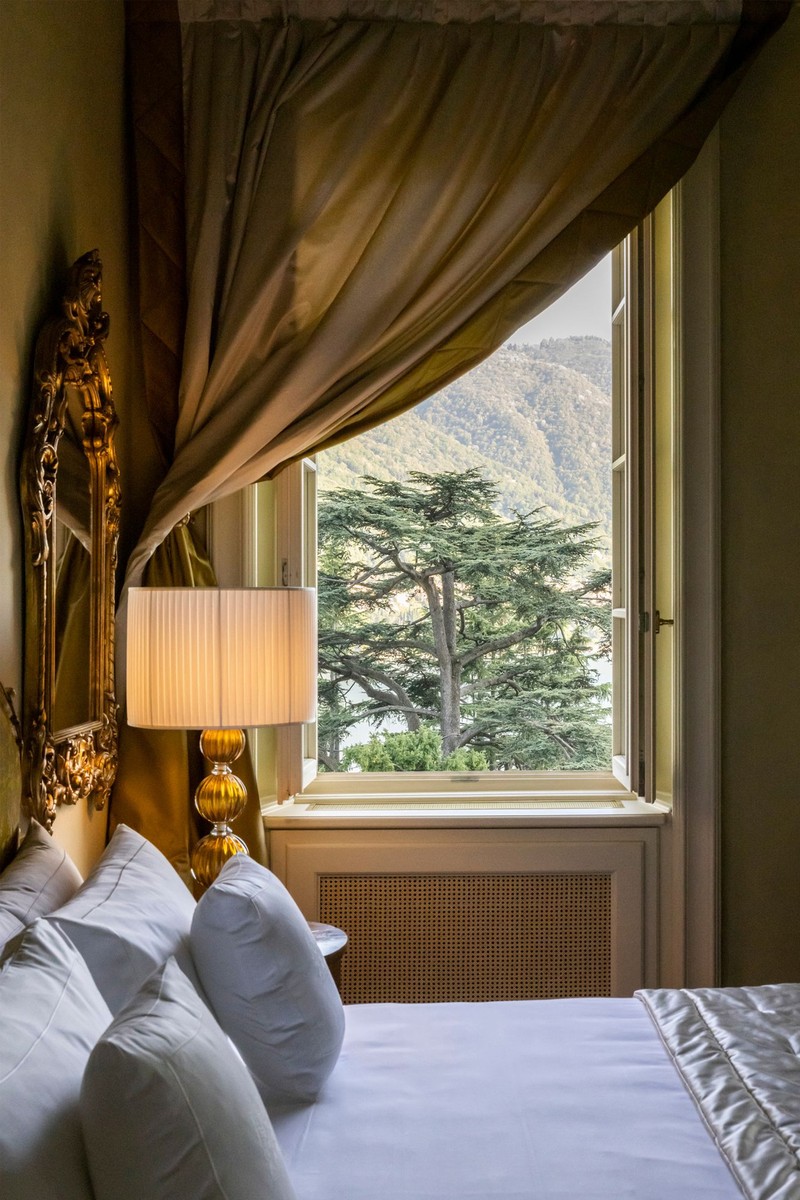
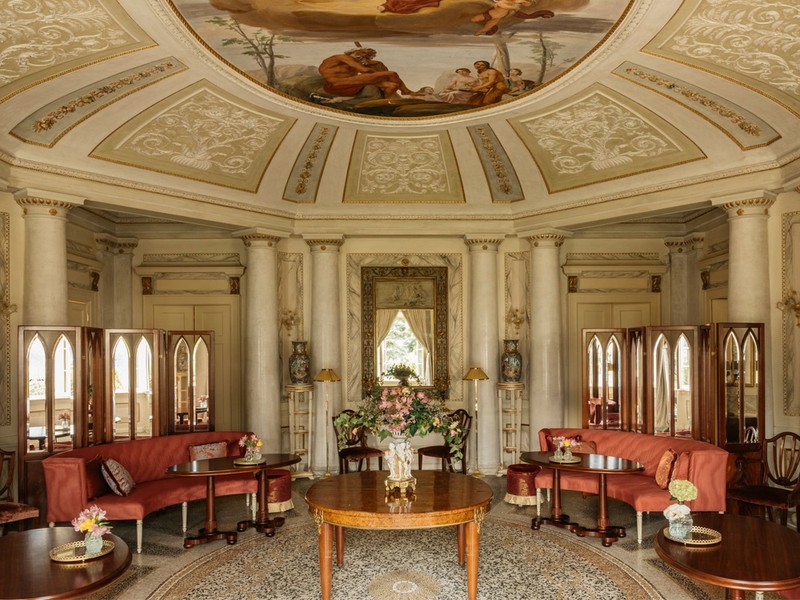
/https%3A%2F%2Fsheerluxe.com%2Fsites%2Fsheerluxe%2Ffiles%2Farticles%2F2023%2F08%2Fitalian-lakes-image-3.jpg?itok=Cyz3e5G-)
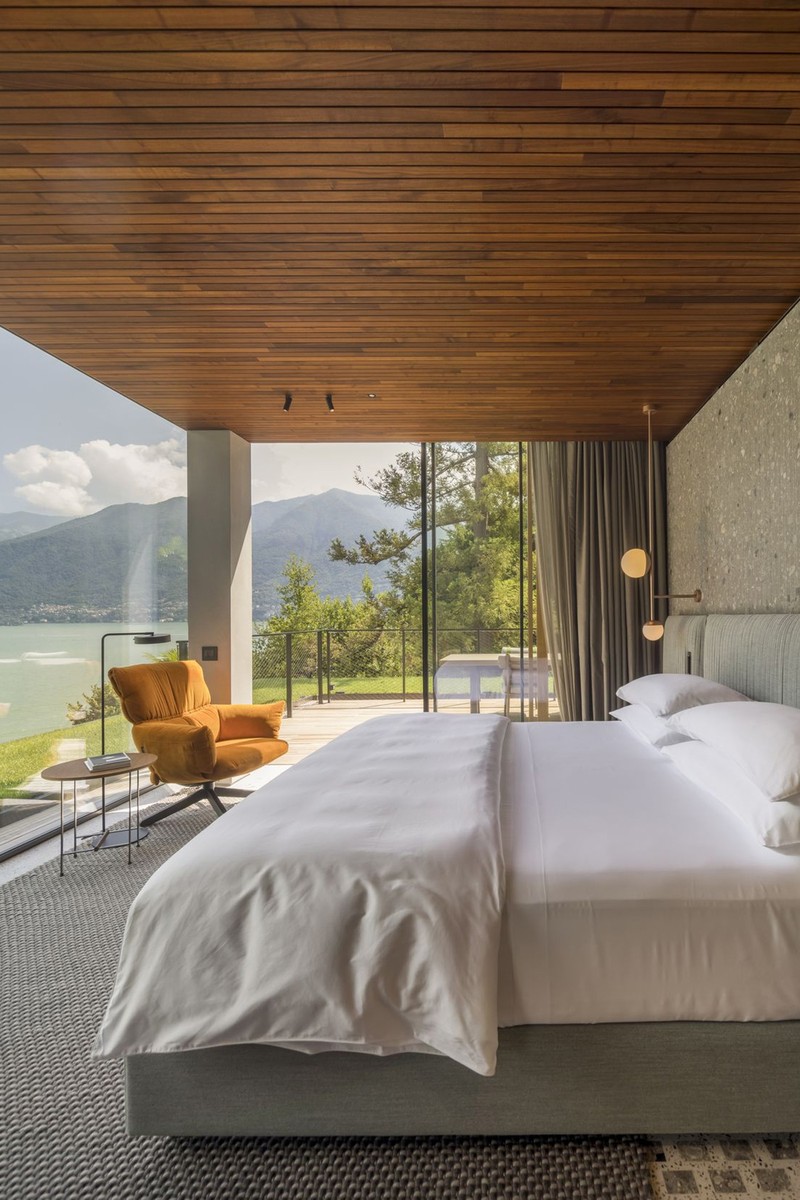
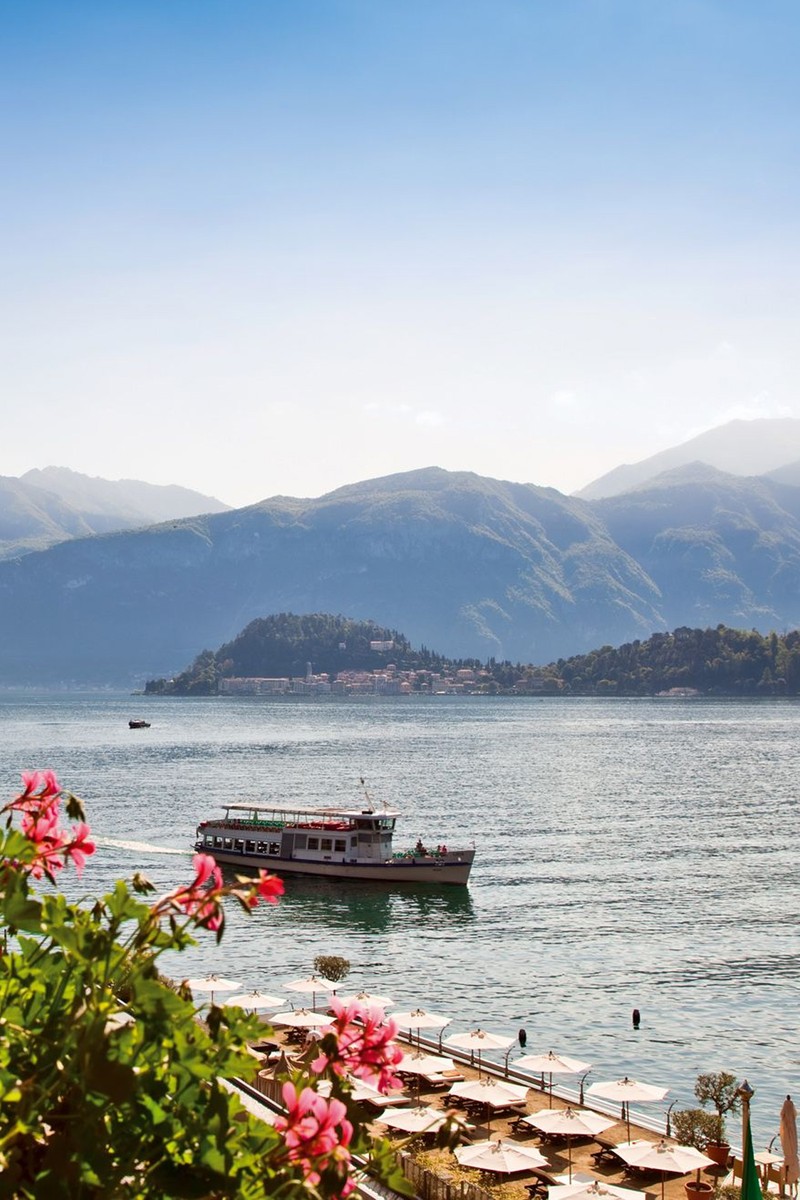
/https%3A%2F%2Fsheerluxe.com%2Fsites%2Fsheerluxe%2Ffiles%2Farticles%2F2023%2F08%2Fitalian-lakes-image-8_0.jpg?itok=oT1ZN4aD)
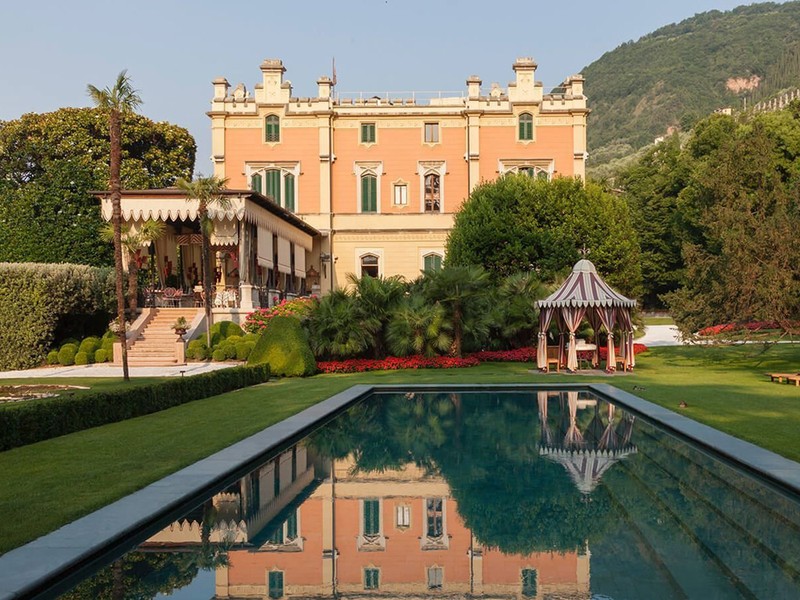


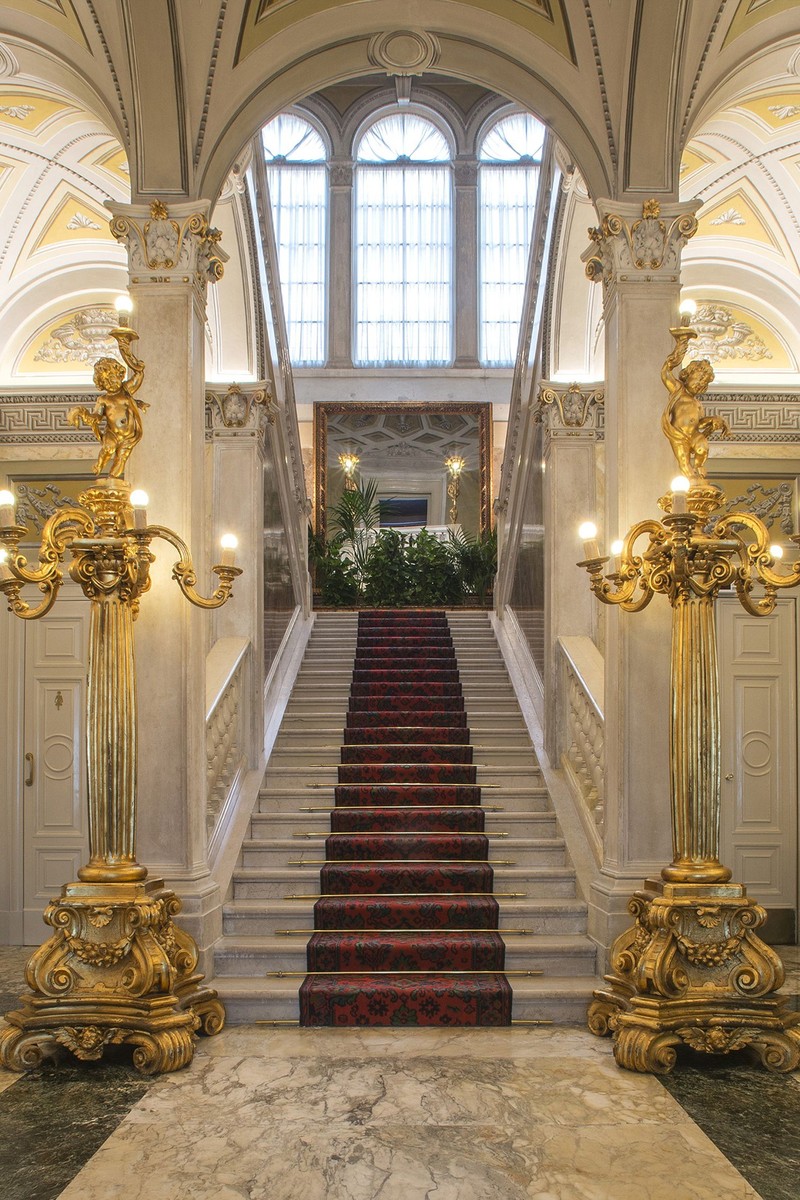
/https%3A%2F%2Fsheerluxe.com%2Fsites%2Fsheerluxe%2Ffiles%2Farticles%2F2023%2F08%2Fnew-italian-lakes2.jpg?itok=wk_bsI6M)
